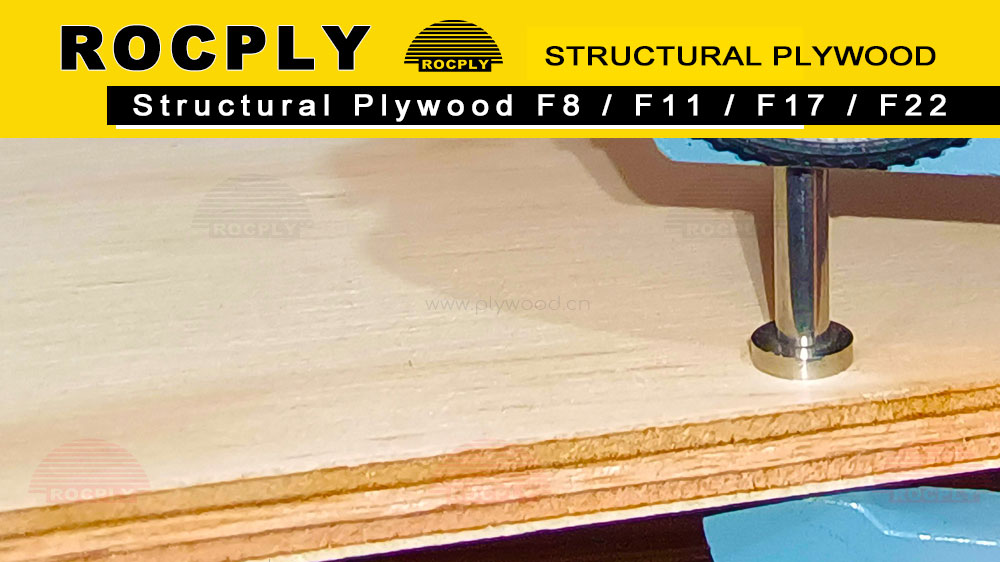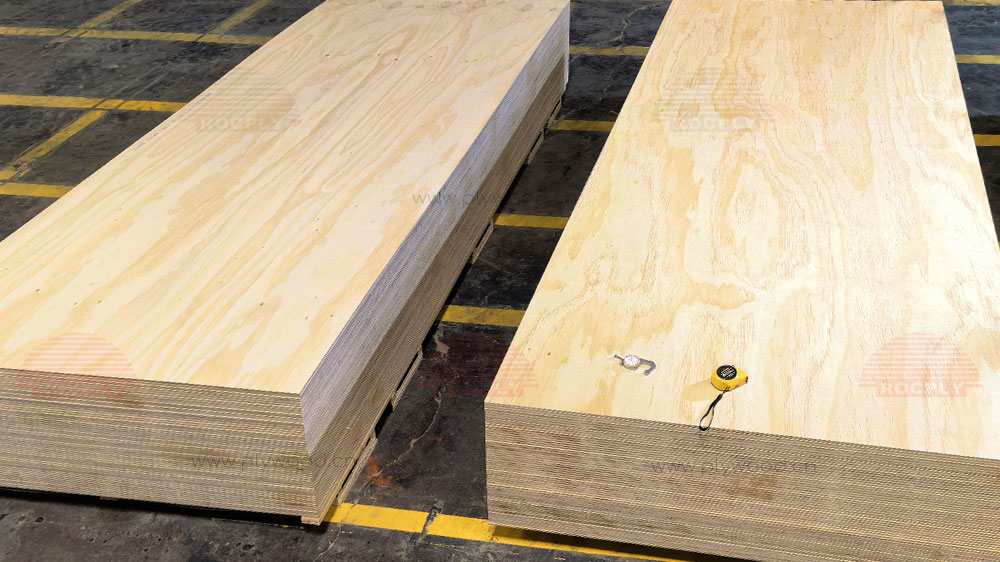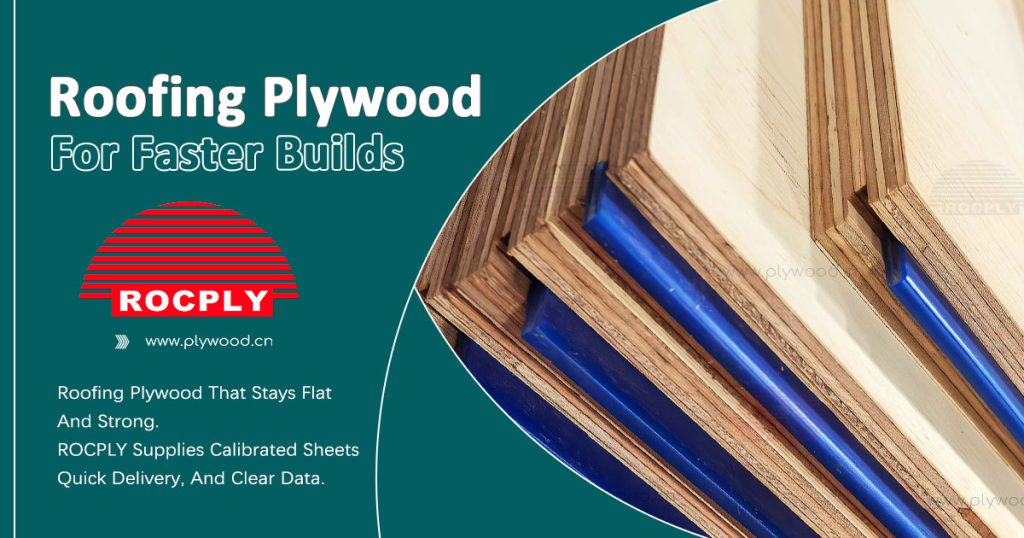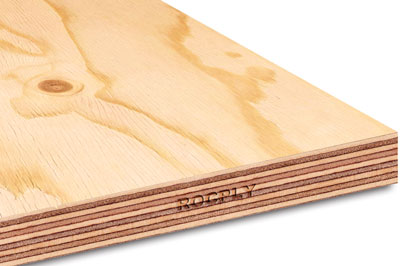Roofing plywood at a glance
Roofs face wind, heat, and rain. They also carry trades and gear. You need panels that install fast and stay stable. ROCPLY roofing plywood brings that mix to every order. Our line focuses on repeat strength and clean fit. The result is a deck that feels firm underfoot.

Why ROCPLY stands out for pros
You want steady quality, not excuses. We grade veneers with tight limits. Moisture sits inside a narrow window. Glue spread stays even across the layup. Press time and temperature follow the spec. Edges trim square and true. Each batch carries a traceable code. You get panels that act the same, job after job.
Sizes, grades, and species for roof decks
A standard sheet measures 1220 × 2440 mm. Other sizes are available by plan. Common thicknesses run 9–25 mm. Homes often use 12–18 mm. Larger spans may call for thicker sheets. Face grades match the finish path. Clearer faces suit membranes and overlays. Utility faces suit hidden zones. Calibrated options support CNC cuts and neat joins.
Roof sheathing performance that crews feel
Real performance shows on site. A stiff deck has less bounce. Screws bite deep and stay tight. Cross plies limit movement as seasons change. Tight cores reduce voids that telegraph. Walk the surface and feel the difference. Subtrades notice fewer ripples under their finish.
Moisture control above the frame
Weather tests every roof. Choose the correct glue class first. A-Bond supports wet cycles and high exposure. Edge seal reduces uptake at cuts. Store packs off the slab with airflow. Cover the top and leave the base open. These simple steps protect the deck and the schedule.
Tongue and groove roof sheathing benefits
T&G edges lock panels together. Joints sit flush and resist steps. Crews move faster on a stable base. Fasteners carry load more evenly. Finishes sit flatter with less prep. Many buyers now standardize on T&G for wide spans.
Roof deck fasteners and patterns that work
Plan your layout before lifting panels. Mark joists to speed nailing. Use the correct fastener length. Glue lines on rafters reduce squeaks. Start fixing at the center and move out. Keep edge distances even. Leave small gaps at walls for movement. Simple rules, strong results.
Roofing plywood for new builds and retrofits
New frames need speed and predictability. Retrofits demand clean integration. ROCPLY supports both paths. Specify thickness by span and load. Pick a face grade to match finish. Select T&G where spans grow. Share roof plans if possible. We map a package that fits each zone.
Roofing plywood and OSB: clear choices
Both sheet types have a place. OSB offers value in dry frames. It needs careful edge spacing and sealing. Plywood gives strong screw grip and quick repair. Edges handle site traffic well. Choose by climate, span, and finish. Our team helps you compare options with real numbers.
Heat, UV, and daily movement
Sun drives heat into the deck. Materials expand and contract. Cross plies help hold shape. Light colors on temporary covers reduce stress. Ventilated storage reduces trapped heat. Small actions keep panels straight. The roof then receives finish without drama.
Membrane, shingle, and metal compatibility
Roof systems vary by region. Membranes like smooth, even bases. Shingles need firm, well fixed decks. Metal roofs prefer straight planes and consistent gaps. ROCPLY sheets meet each need when installed right. Ask for our fastening notes by system. Your installer then starts with clarity.
Jobsite handling that avoids damage
Fork pockets improve safe lifts. Corner guards protect edges in transit. Barcoded labels speed intake at the yard. Crews move packs with fewer scrapes. Keep sheets on bearers, not concrete. Lift, do not drag. Small habits save time and money.
People also ask about roofing plywood
What thickness is best for roof decks?
Common spans use 12–18mm plywood. Wider spans often need 18–21 mm.
Is plywood better than OSB for roofs?
It depends on climate and finish. Plywood offers strong screw grip and easy repair.
Do I need tongue and groove edges?
T&G helps control steps and noise. It is great for wider spans and long runs.
Which grade should I choose?
Pick clear faces for visible or membrane contact. Choose utility faces for hidden areas.
Is roofing plywood waterproof?
No panel is fully waterproof. Correct glue and edge seal resist moisture well.
How do I stop roof squeaks?
Use glue on rafters and correct fastener patterns. Fix sheets before frames take on moisture.

Span tables, loads, and safety
Design should lead the choice. Share spans and expected loads. We return practical advice and data. The right sheet stops bounce and nail pops. A clear spec also prevents change orders. Everyone wins when decks feel solid on day one.
Inspections and compliance made simple
Auditors want traceability. We label every pack with batch codes. Documents ship with each load. You get quick access to species and mill data. Compliance teams appreciate that clarity. Bids move faster with clean files.
Packaging that protects value
Transit risks edges and corners. We use PET straps and board guards. Waterproof labels survive long routes. Pallets allow access from both sides. Mixed loads still land organized. Your warehouse scans and stacks with speed.
Cost, value, and total savings
Price matters, but time matters more. Panels that install fast save labor. Panels that stay flat reduce callbacks. Strong decks support smoother finish trades. Logistics also count. Smart pallet plans reduce handling. The total program costs less when everything works together.
ROCPLY roofing plywood support for wholesalers
Distributors need rhythm and choice. We plan rolling orders with you. Packs match your racks and aisles. Mixed grades support diverse buyers. Spec sheets and photos help your team sell. Your network gains confidence with every delivery.
How ROCPLY reduces common pain points
Flatness and fit. We sand to tight tolerances for smooth seams.
Strength with control. Layups target stiffness along the major axis.
Moisture defense. Edge seals and correct glue resist cycles.
Noise control. T&G plywood and clean fixing reduce creaks.
Reliable supply. Forecasts and safety stock limit gaps.
Roofing plywood applications by segment
Homes need strong decks with quick installs. Builders value speed and clean seams. Our panels support both goals with ease.
Residential new builds.
Use 12–18mm sheets on standard spans. T&G edges reduce steps under shingles. Crews move fast and stay safe.
Residential re-roof.
Match thickness to existing framing. Add blocking at cutouts and valleys. Seal every fresh edge before cover.
Commercial roofs.
Choose thicker sheets for traffic and gear. Tighter spans limit bounce. Roof deck plywood improves flatness for membranes.
Schools and healthcare.
Noise matters in these spaces. Use underlayment layers where needed. Tidy seams help meet acoustic targets.
Industrial sheds.
Fork lifts and plant add point loads. Specify heavy sections and short spans. Check uplift and fix patterns carefully.
Coastal and high wind zones.
Select A-Bond glue lines. Increase fastener density at edges. Add clips where codes require.
Advanced detailing that saves time
Good details prevent call backs. Small choices improve the whole system.
Ridges and hips.
Keep joints centered on framing. Stagger seams as you approach the ridge. Maintain even gaps for movement.
Valleys.
Run panels tight to valley members. Pre-mark fastener lines for speed. Seal every cut edge before cover.
Eaves and drip edges.
Support every panel edge with timber. Add backing where spans exceed limits. Prime exposed edges after trimming.
Openings and penetrations.
Frame out skylights and vents. Never leave free edges without support. Use additional screws around the opening.
Ventilation and heat control.
Provide airflow under the finish. Light temporary covers reduce heat. Panels stay flatter through long builds.
H-clips and blocking.
Clips help where T&G is not used. Blocking supports square edges on wide spans. Both methods keep planes true.
Plywood roof sheathing vs alternatives
Choices depend on climate and finish. The right call protects budgets and time.
OSB vs plywood roof.
OSB offers value in dry frames. It needs careful edge spacing and sealing. Plywood gives strong screw grip and quick repair.
Structural plywood advantages.
Cross plies limit movement. Veneers hold fasteners well. Repairs are simple and fast on active sites.
Moisture management.
Moisture resistant plywood helps in humid zones. Edge seal adds another layer of defense. Store packs off the slab with airflow.
Roofing plywood installation workflow
A clear workflow improves quality. It also keeps people safe.
1. Verify spans, loads, and fix patterns.
2. Plan the layout with staggered seams.
3. Mark joists before lifting sheets.
4. Apply glue lines to rafters or trusses.
5. Fix from the center and move outward.
6. Keep edge distances even and neat.
7. Seal every cut and notch at once.
8. Inspect lines, then release to finish trades.
Code and best practice
What fasteners should I use?
Use nails or screws approved by the local code. Match length to thickness and span.
Do I need underlayment over the deck?
Most systems require it. Membranes prefer smooth bases with tidy seams.
How far apart are fixings?
Edge spacing is often closer. Field spacing can be wider. Follow local rules and the engineer.
Can I walk on the deck before cover?
Yes, with care. Add temporary protection for long waits.
How long can panels stay exposed?
Minimize exposure time. Use A-Bond and edge seal if delays occur.
How long can panels stay exposed?
Minimize exposure time. Use A-Bond and edge seal if delays occur.

Troubleshooting on the roof
Most issues trace to storage or fixing. Quick checks solve them fast.
Cupping or twist.
Review storage and airflow first. Re-fix with correct fasteners where needed.
Nail pops.
Check moisture and span. Replace with screws if frames moved.
Edge steps.
Add blocking or switch to T&G edges. Re-set fasteners to pull planes true.
Squeaks.
Use adhesive on framing. Re-fix with the correct pattern and length.
Surface ripples under finish.
Confirm span limits and fastener density. Replace any damaged sheets.
Compliance, documents, and traceability
Tender packs need clean data. ROCPLY supports that step.
We supply batch codes on every pack. Labels carry species and mill info. Files include glue class and grade notes. You can audit runs against the code. Your compliance team gains quick answers.
Roofing plywood Sustainability and low-risk sourcing
Buyers ask for proof. We maintain documented chains of custody. Mills record species and regions. Independent audits review process and files. Packs ship with traceable labels. Your bids move faster with clear records.
Packaging and logistics for fewer claims
Transit can harm corners and faces. We prevent that loss.
Packs use PET straps and solid guards. Pallets allow access from both sides. Waterproof labels stay readable on long routes. Barcodes speed intake at your yard. Mixed loads still stack cleanly by zone.
Buying checklist for busy teams
Use this list to order fast and right.
– Size and thickness for each roof zone.
– Grade and face for the chosen finish.
– Glue class for climate and exposure.
– T&G edges or square edge with clips.
– Edge seal color and cut-edge policy.
– Pallet counts, gross weight, and fork access.
– Barcode formats for your warehouse system.
– Delivery window and site access rules.
– Required documents and batch trace codes.
Training tips for installers
People make the difference. Short refreshers pay off.
Walk new crew through spans and patterns. Show correct edge distances. Practice sealing cuts before cover. Review storage and airflow rules. Small habits protect the whole roof.
Maintenance and long-term checks
A good deck starts right. It also stays right with simple checks.
Inspect after major storms. Look for fastener movement at edges. Watch for signs of trapped moisture. Repair damaged areas at once. Quick action avoids bigger work later.
Digital support for estimators
Speed matters during bids. Data saves hours.
We share span tables and weight charts. You get pallet plans and container counts. Photos and spec sheets help sales teams. Your quote goes out clean and fast.
Why pros return to ROCPLY
Results build trust. Service keeps it.
Batches arrive on time. Panels act the same across jobs. Documents land with the load. Claims drop year over year. Your teams deliver with confidence.
ROCPLY call to action
Share your spans, finish system, and climate. We will map a deck package that fits. ROCPLY roofing plywood ships ready to install. Your crews move fast with fewer fixes. Ask for samples, data sheets, and a live quote today.
Quick glossary for site teams
Roof deck plywood.
Panels that form the structural base of the roof.
Plywood roof sheathing.
Another term for the same deck layer.
Tongue and groove roof sheathing.
Panels with locking edges for flatter planes.
A-Bond.
Exterior glue class for wet cycles and heat.
Edge seal.
Coating that reduces water uptake at cuts.
Where roofing plywood fits
Roof sheathing describes the deck layer under the finish. Plywood roof sheathing highlights the material choice. Roof deck plywood focuses on the structural role. OSB vs plywood roof compares value and repair speed. Tongue and groove roof sheathing improves flatness on wide spans. Moisture resistant plywood helps in humid or coastal zones. Structural plywood supports high loads and long runs.
Wholesale supply program for roofing plywood distributors
Stock the grades your market needs. Keep T&G and square edge options. Offer A-Bond for wet or wind zones. Share our span tables with your customers. ROCPLY helps you sell with clear data and steady supply.

Structural Plywood AS/NZS 2269 Certified
Post time: Oct-20-2025

